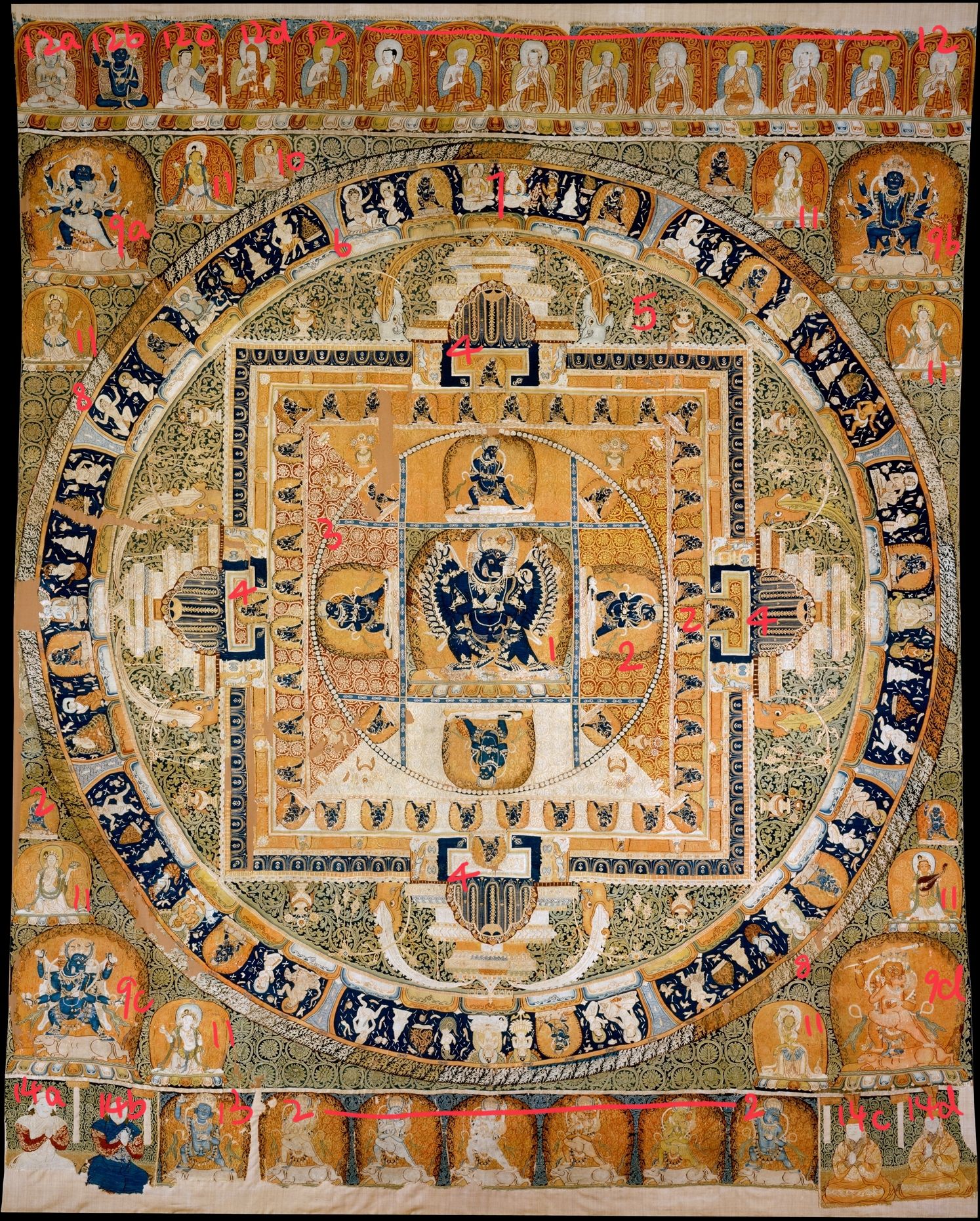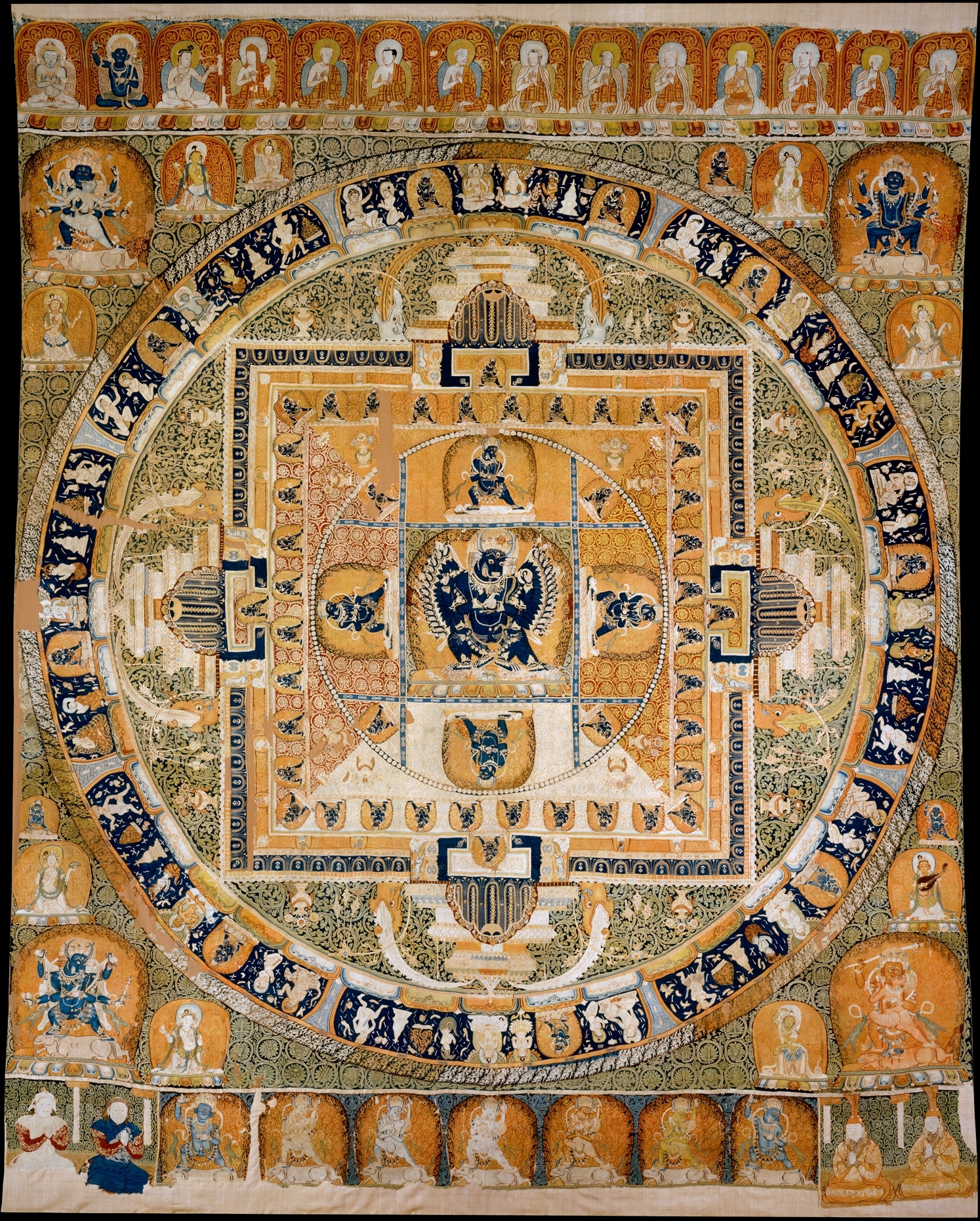By Shelly zhongyin Zhang
Introduction
Featured in a recent exhibition-“Another World Lies Beyond: Chinese Art and the Divine”, the Vajrabhairava Mandala (ca. 1330-32) came in front of the general public after 10 years of sleeping in darkness. In fact, it has received tremendous attention from scholars after its acquisition by the museum in 1992. Not only was it mentioned in various publications of the Metropolitan museum, it was also thoroughly examined by Chinese art historian Shao Yan in an article back in 2017.
With a warp of 245.5 cm (96 5/8 in.), and a weft of 209 cm (82 1/4 in.), this Mandala is the biggest out of all the extant kesi works of the Yuan Dynasty. (Fig. 1) Its uniqueness also lies in the depiction of the donors, which directly point to the fact that it is a court-commissioned work. In addition, the presence of the inscriptions reaffirms its court origin. Situating this work in an art-historical context, this article aims to analyze its uniqueness within the history of textiles and court art.

Kesi in Thangka

Kesi, unlike the continuous brocade, features colored weft threads weaving around warps to create a colorful design. Each color requires a separate bobbin to weave the weft in (Fig. 2), and therefore the weaving process can be extremely time-consuming. As a textile-weaving technique itself, kesi possesses the most unsolved myths and unanswered questions regarding its origin. While recent scholarship can identify groups (Central Asian, Tangut, Uyghur and local Chinese) that were adept at this technique, its early development can barely be fully retrieved.
From the Northern Song to the Southern Song, the kesi technique gradually departed from the Central Asian prototype. It finally gained its special functionality during the Yuan dynasty. Upon Temür (1265-1307)’s accession, kesi was used to reproduce imperial portraits, as recorded in Jingshi dadian (Records of Yuan institutions). Sometimes, detailed orders of mandalas with imperial portraits were given.ii The Vajrabhairava Mandala from the Metropolitan Museum belongs to one of the imperial commissions. According to Shao Yan, thangkas are categorized as Guotang and Zhitang by modern scholars.iii While the former refers to those weaved/knitted silk thangkas, the latter refers to those that are painted/printed. The mediums of Zhitang can vary from Silk to Paper. This Metropolitan mandala belongs to the Guotang category, which is more precious.

A Mix of Styles: Chronological and Geographical
Situating the Vajrabhairava Mandala in the history of Buddhist textiles, it belongs to the Sakyapa school. Though it lacks the predominant red color that appears in most Sakya thangkas, it does possess several features of the Sakyapa school. As suggested by Dr. Pratapaditya Pal, distinctive features of the Sakya school involve the linearity of forms and the registers of shrines both on the top and the bottom. The geometrical scheme and the carefully calculated positions of the shrines surrounding the central deity are typical of the Sakya school.
Geographically, this thangka features a mix of styles of Tangut, Uyghur and local Chinese people. An indication of its Tangut influence is the long, tangled threads on the reverse side. (Fig. 3) James C. Watt speculated that the exposed threads are because of the diversity of population in Tangut Xia and Yuan territories. The Western Xia(1038-1227) or Xixia reign, was established by the Tangut in the north-western part of China. It has a population mixed with Turfan, Uyghur and Tangut ethnic groups. Out of the three ethnic groups, the Uyghurs were considered as the original carriers of the kesi technique. Not only was the earliest kesi tapestry discovered in the Turfan area, the first supervising official of kesi weaving in the Yuan court-Tang Renzu (d. 1301)-was also of Uyghur origin.
While Watt focused on the Uyghur and Tangut elements of this Vajrabhairava Mandala, Chinese scholars suggest that this piece could have a Han Chinese origin. The controversy of its origin lies in the use of gold leaves. Taste-wise, the preference for the gold leaf seems to be of a nomadic tradition, the technique of sewing gold leaf onto tapestries is of local Chinese tradition. In the meantime, the Vajrabhairava Mandala is pre-sewn in parts and assembled. Shao Yan therefore speculated that this piece was weaved originally in parts in Hangzhou, and sewed together in Daidu (modern Beijing). The assembling process might owe to the fact that it was transported from Hangzhou to Daidu; however, we could also argue that it is because the size of a kesi machine. If the size of the tapestry can be weaved on the kesi machine is limited, then the two-step weaving process is a must. This problem gets even more complicated taking into account that Hangzhou had considerable Tibetan influence at that time.
Iconography and Inscription
The central deity of the Vajrabhairava Mandala is a wrathful manifestation of Vajrabhairava (also known as Yamantaka). Based on the Metropolitan catalogue’s English description and Shao’s Chinese translation, the iconographical identification is as follows:

1. Vajrabhairava (Yamantaka)
2. Yama Dharmaraja
3. Kapalas (skulls)
4. Gates guarded by Yama Dharmarajas
5. Vases for purification
6. Lotus
7. Graveyards for purification
8. Fire
9a. Four-arm Shabhuja with Chaturbhuja
9b. Six-arm Shabhuja
9c. Dharmaraja
9d. Amrtakundali
10. Mahasiddha
11. Female deities of lower rank
12. Lamas
12a. Primordial Adi-Buddha Vajradhara
12b. Dharmapala (a form of Mahakala)
12c. Mahasiddha Virupa (Birvapa)
12d. Could be one of these three: dKon-mchogrGyal-po (1034-1102); Sa-skya-pa Kun-dga sNying-po (1092-1158); Phagspa (1235-1280)
13. Mahakala
14a. Tugh Temür
14b. Qoshila
14c. Bhudhashri
14d. Bhabucha
If the presence of the imperial donors indicates its court origin, then the inscription pinpoints its date:
Bottom right corner:
“dPon mo ‘Bha bu cha” (the lady Bhabucha)
“dPon mo bHu dha shri” (the lady Bhudhashri) (Fig. 5)
Tugh Temur was proclaimed emperor for the first time in 1328, because he reached Daidu prior to to his brother Qoshila while contending for the throne.(Fig. 4) During his reign, Qoshila was said to be the prince.viii At the beginning of 1329, Tugh Temur abdicated in favor of Qoshila, and following the addiction was supposedly the happy reunion between the brothers. However, Qoshila died during a reunion with his brothers in the august of 1329 and he was said to be poisoned by a powerful official El-Temur. This article will not go in-depth into the complicated relationship within the Yuan court, but the emperors’ brief reigns could allow us to infer a time frame for this kesi work.


James C. Watt considers that this piece was commissioned before Babusha’s death in 1330, and completed after Tugh Temur’s death in 1332. This dating is seemingly problematic given the inscription, which indicates that the Metropolitan mandala was made when Tugh Temur was the emperor and Qoshila as the prince. However, both female figures are titled as “the lady[emperor’s wife]”. If Qoshila has never come to the throne, then it becomes contradictory if his wife Bhabucha is titled “the lady”. Possible explanations include Tugh Temur tried to legitimize his throne by self-claiming Qoshila as the prince, or Qoshila’s memorial plate hasn’t been moved into the ancestral temple when this mandala was inscribed. The paradox between the inscriptions of the ladies and the emperors still remains unsolved.



